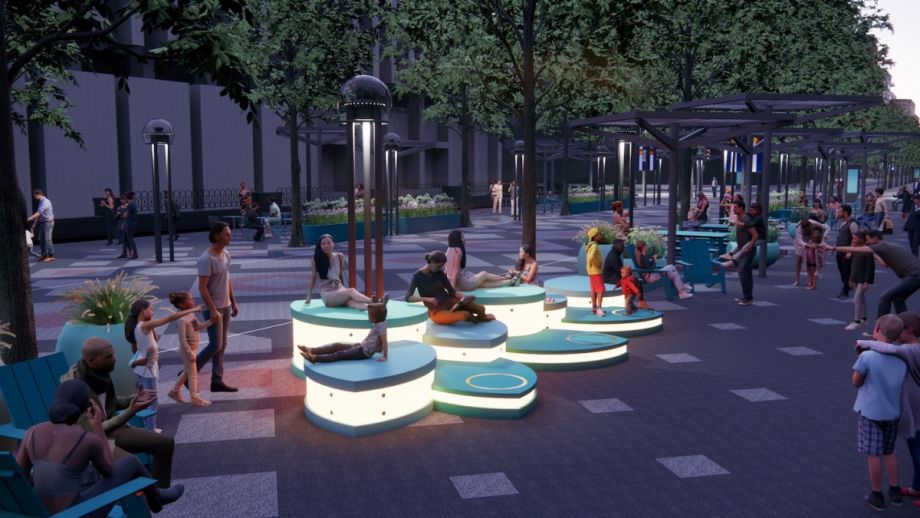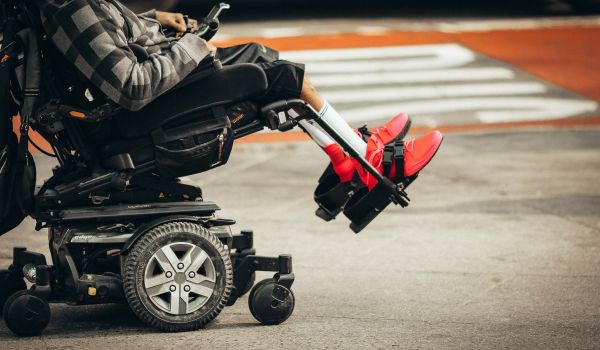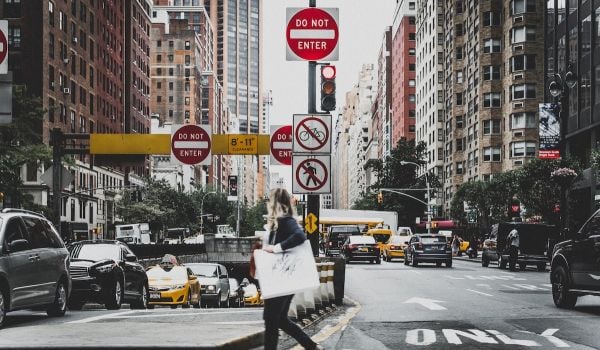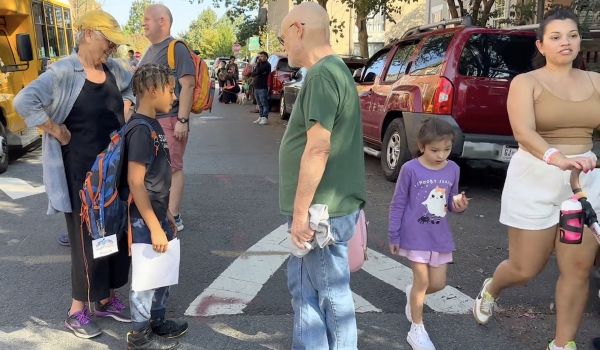In the heart of American cities big and small, the way we view our streets is changing. Long recognized globally for our absolute embrace of car culture, Americans are rethinking what streets can be and how they can function.
The concept of closing streets gained major traction during the pandemic, first out of necessity and then as a result of the success – both economic and social – of embracing more pedestrian-friendly urban thoroughfares.
There’s an overwhelming desire in the U.S. for more livable and walkable cities: A 2022 survey by the American Planning Association found that 83% of Americans support the creation of more pedestrian malls in their communities. A recent study by the Urban Land Institute adds another layer to this narrative, revealing that 70% of real estate developers believe pedestrian malls will be more important in the future than they are today.
These findings suggest that pedestrian malls are not just a passing trend but are becoming increasingly vital elements in shaping the urban landscape. But, as I’ve found in my work as an urban designer and landscape architect, a successful pedestrian mall requires far more than curb-less sidewalks or limited vehicle traffic. To take these streets beyond mere thoroughfares and truly realize their benefits, cities, landscape architects, planners, urban designers, and private industry must work together to realize the substantial social, economic, and environmental possibilities.
Streets as neighborhood activity hubs
Salt Lake City’s forthcoming Main Street pedestrian mall project has deep roots in visionary planning and community aspirations spanning decades. The idea of making Main Street a “pedestrian paradise” originates from Salt Lake City’s 1962 Second Century Plan, which called for a vibrant, pedestrian-centric Main Street, an ethos this latest project embraces along with modern urban preferences for walkable cities.
By also adopting the principles of the city’s 2016 Downtown Plan and responding to widespread support for pedestrian-friendly spaces, the planners, architects and designers at Dig Studio – where I work – are creating a “Together on Main” plan for the four-block stretch in the heart of downtown. The streetscape will support a rapidly expanding residential population by putting pedestrians and activity first.
The most important first step was understanding what the many diverse stakeholder groups need and want from the space – from local businesses, residents and visitors to the transit authority and the city government. Feedback from on-site workshops and surveys, both in person and online, is guiding the design of a functional hybrid street that seamlessly integrates transit, businesses and – most importantly – activation.
Armed with this input, Main Street is poised to become more than a means of getting from A to B. It will become a massive, inclusive and vibrant public living room, addressing the needs of Salt Lake City’s growing population while preserving vital transit operations.
Creating moments of joy
Part of turning these streets into destinations is creating the infrastructure to support ‘moments of joy’ for gatherings of all sizes. One example is the Pearl Street Mall in Boulder, Colorado. Lauded as Boulder’s “crown jewel,” this four-block pedestrian mall is a beloved destination for local families, college students and tourists situated in the heart of downtown. Its whimsical and child-friendly environment, public art installations, pop-up street performances and stunning views of Boulder’s Flatirons provide a one-of-a-kind space where community and economy thrive.
In Denver, a massive redevelopment project of the iconic I.M. Pei-designed 16th Street Mall is currently underway. Similar to Salt Lake City, the goal is to create places that encourage people to gather, interact and connect. With that in mind, we’re working to transform the 1.25-mile length of the mall into a multi-faceted community hub, with programmed and unprogrammed activators – like cleverly designed seating areas that invite you to pause and people-watch as you shop or on your lunch hour. Safety and ADA-compliant accessibility are also key priorities to ensure a diverse range of age groups and visitors feel welcome.
The key is to determine what will make the space fun and interesting on a day-to-day basis while ensuring flexibility for events. That means the ability to accommodate crowds ranging from 200 to 2,000 to 200,000, by even fully shutting down 16th Street for large events like parades. To that end, the project is prioritizing infrastructure updates, working closely with engineers to ensure the revitalization of both physical and programming aspects — and creating a vibrant and adaptable urban space that resonates with the community.
Addressing environmental injustices
Pedestrian malls not only yield social and economic benefits, but they can also play a pivotal role in addressing environmental, health and equity issues within cities. Beyond the natural benefits to air quality that come with reducing automobile traffic, the design of these spaces can contribute to improved water quality, decreasing runoff from streets and parking lots and filtering stormwater before it runs through to the next basin. Consider the Nicollet Mall in Minneapolis, which has reported a reduction of stormwater runoff by up to 60%.
These malls additionally aid in creating more green space in notoriously hot, paved urban areas like the Fremont Street Experience in Las Vegas, which has increased its natural shade cover by up to 20%. As part of the redesign, Denver’s 16th Street Mall project will now feature America’s largest installation of trees with a suspended paving system. The design will mitigate the urban heat island effect through an expanded urban tree forest and advance the city’s efforts to enhance its below-average urban tree canopy.
Spurring private development
Pedestrian malls aren’t altruistic – they can be a powerful tool to boost economic activity. Take Santa Monica’s Third Street Promenade. With over 200 shops and restaurants, it has become a hotspot both locally and as a major tourist attraction in L.A., generating over $1 billion in economic activity annually, according to a study by the City of Santa Monica. Likewise, construction is underway along San Francisco’s Market Street with the aim of revitalizing the city’s most prominent thoroughfare.
We followed a similar approach on Vermijo Avenue in Colorado Springs, transforming a former underutilized warehouse district into a vibrant, pedestrian-friendly streetscape with the goal of spurring private investment and anchoring the recently-built U.S. Olympic & Paralympic Museum. The curbless, festival-style street provides flexibility for a multitude of uses – from street fairs to farmers markets – and seamlessly connects downtown Colorado Springs with the museum.
Sustaining success
Perhaps the most important takeaway as cities look to meet the growing public demand for more pedestrian-oriented spaces is the importance of thoughtful and continuous activation strategies. A 2022 study by the Downtown Management Network underscores the critical role of robust activation programs, revealing that malls with such programs experience higher foot traffic, increased retail sales and more favorable attitudes from visitors.
This is not a case of “if you build it, they will come.” Sustained activation, encompassing diverse programming and events are the key to long-term success – from events like concerts and farmers markets, to the installation of public art pieces, to the creation of communal gathering spaces. Retail programming and community engagement further contribute to the vitality of these spaces.
Prioritizing thoughtful, ongoing activation helps cities ensure the immediate success of their pedestrian malls and cultivate thriving urban environments that endure.
In the evolving landscape of American cities, shared streets are proving to be catalysts for economic growth, social connectivity, and environmental sustainability. Embracing the potential of pedestrian malls is an opportunity to create enduring, vibrant spaces that enhance the quality of life for all people.
Bill Vitek is a Principal at Dig Studio, an award-winning landscape architecture, urban planning and design firm with offices in Denver and Phoenix. Bill has over three decades of experience envisioning healthy, sustainable places in cities across the US, with a focus on crafting memorable, well-designed environments that add lasting value for communities.













